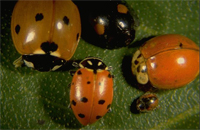|  Lady
Beetles (Lady Bugs) Lady
Beetles (Lady Bugs)
Order: Coleoptera
Family: Coccinellidae
Scientific Name: Various
Color: Red, orange, yellow, brown or shiny black,
with various markings
Legs: Six
Shape: Broadly oval to nearly round
Size: 1/32-3/8" long
Antennae: Yes
Flight: Yes
Lady beetles are highly beneficial insects, feeding on aphids,
scales and mites. Some species have a habit of overwintering in
structures and are therefore nuisance pests. They are found worldwide
with about 475 species occurring in the United States and Canada.
Habits
Fed female adult beetles lay yellow oval-shaped eggs in clusters
or singly near infestations of aphids or other pests. Larvae hatch
from eggs and develop through several molts (instars) until they
pupate. Development from egg to adult takes 2 to 3 weeks.
Habitat
Mouthparts are for chewing. Larvae and adults feed primarily on
aphids, but they will also feed on scales, eggs of caterpillars
and other soft-bodied insects and mites. Adults occasionally feed
on nectar, pollen and honeydew (exudate of aphids and other sucking
insects). Adults disperse seeking feeding and reproduction sites.
Threats
Beneficial; natural enemy; predaceous adults and larvae; medically
harmless.
Control
Outside, none. This is a beneficial insect. Inside control by vacuuming.
To help reduce numbers entering a structure, exclude by screening
vents, caulking around utility entrances and door/window frames.
(Source: National Pest Management Association, et. al.)
|